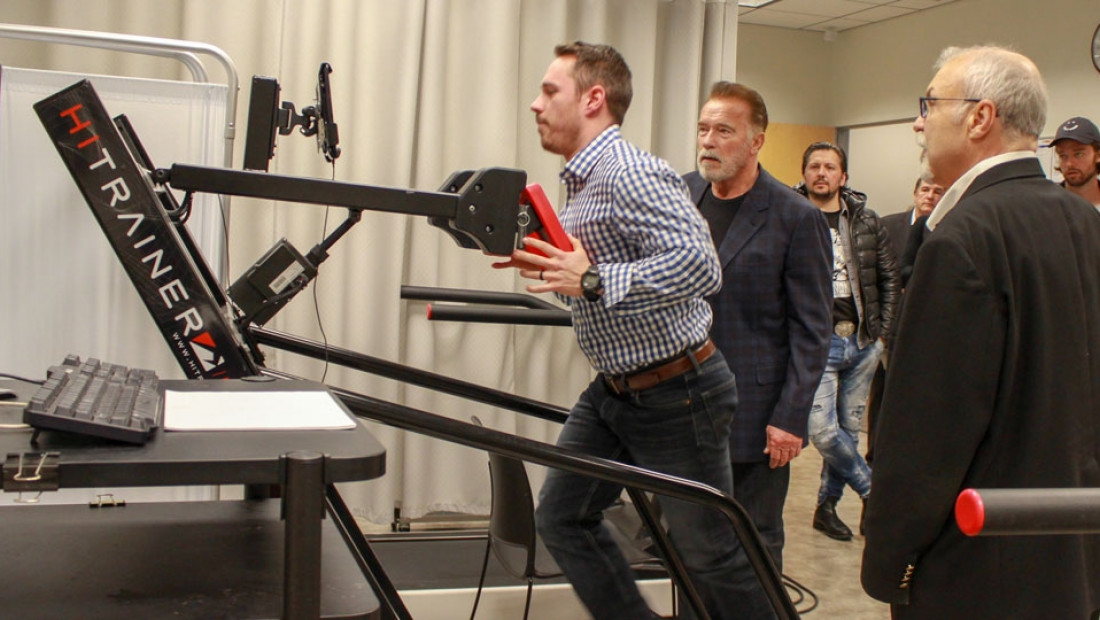
Post-doc Rich LaFountain, PhD, demonstrates a sprint trainer for Arnold Schwarzenegger during a visit of kinesiology labs at The Ohio State University March 4.
Before departing the city of the sports festival named after him, Arnold Schwarzenegger on Monday visited Ohio State’s College of Education and Human Ecology to get a crash course in exercise physiology.
The Terminator toured the Department of Human Sciences kinesiology labs in the Physical Activity and Educational Services building to see the science behind what can make Strongmen (and Strongwomen) even stronger. Eight to 10 of the competitors, in fact, had been in the labs that morning for health screenings and to participate in the college’s research.
Schwarzenegger, his entourage and Dean Don Pope-Davis found fully equipped, state-of-the-art neuroscience and neuromuscular labs that measure everything from sprinting capability to the brain functions for performing strength training.
William Kraemer, professor of kinesiology, and his doctoral students gave the fitness master an overview of their research. Their mutual friend, Arnold Sports Festival cofounder Jim Lorimer, was there to hear the highlights.
“We’re delving into the body and understanding what’s going on,” Kraemer told Schwarzenegger. “We’ve been doing it for years. Now we can bring the metrics to life in every area to really understand performance and how the body is functioning.”
To illustrate, doctoral student Parker Hyde showed Schwarzenegger how putting a transducer against the weightlifting legend’s thigh could measure his muscle structure. Going a step further — looking at how the muscle fibers are positioned — can help estimate how fast or strong a muscle can fire.
“Our primary goal is how the training program is affecting the measures of performance that we're trying to improve,” Kraemer explained. “We have the technology. You bring your genetics and hard work but we want to understand how all the factors are integrated to improve performance.”
Doctoral fellow Lydia Caldwell and an undergraduate student illustrated the lab’s unique float room, which uses nearly 1,000 pounds of Epsom salt to suspend an athlete in a space about the size of a laundry room. The team is looking at how floatation therapy — no light, no sounds, no stimulation — can induce deep relaxation and help people recover from exercise fatigue and heal injuries more quickly.
“So we’re studying the brain, we’re studying the heart, we’re studying what’s in the blood — all with this relaxation technique,” Caldwell said. “You see he’s floating without any sort of effort at all.”
“Due to the salt?” Schwarzenegger asked.
“Yes,” Caldwell said. “When the door is closed, you can’t see your hand in front of your face. So, it is so dark. There is no sound. It takes the strain off your muscles. We know it’s good for blood flow.” This helps achieve a deep relaxation state.
Someone tried out the lab's quick board — which they jokingly called “Dance Revolution" — mimicking with his feet the movement he saw on a monitor.
“Come on now, do it!” Schwarzenegger urged him.
The setup can be fully wired, Kraemer said, to monitior the brain, heart and muscle movements. This shows the metrics of athletes’ reaction times from their brains to their feet.
“We were the first to show this integrated way of watching the brain fire, the muscles contract and the foot move. We can see the whole kinetic chain of action and understand how the process works or what problems exist,” he said.
One of the lab monitors showed the bone density and impressive muscle mass of a Strongman competitor. The research on those athletes, like the Arnold Classic, has been longitudinal, over the past five years.
Back then, professors Jan Todd and Terry Todd, from the University of Texas, started the Strongman Competition in conjunction with Jim Lorimer and his son, Bob. They worked with Kraemer to advance the science of health promotion behind the competition.
Since then, college researchers have watched the Strongmen grow and their bodies change. The two-time winner and Game of Thrones actor, Hafthor Bjornsson, topped 450 pounds this year. The kinesiology research team is in a unique position to provide supersize health screenings and research, to help athletes like Bjornsson maintain their health and improve their performance.




